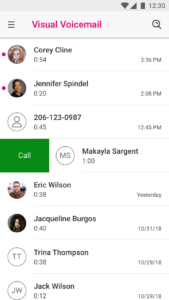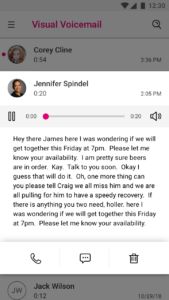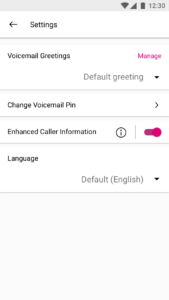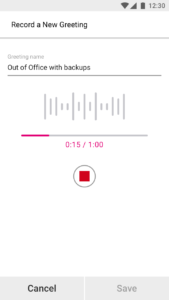
Project Directive
Boasting a tens of millions strong install base and millions of daily users but a flagging rating in the Play Store coupled with a decade old design rooted in antiquated dial-in voicemail paradigms, it was clear that a wholly new approach was needed to deliver what customers needed in a voicemail app. In order to leverage the stratospheric increases in mobile phone performance and the ubiquity of cloud storage and computing, I was asked to wipe the slate clean and redesign Visual Voicemail with a focus on meeting customer expectations in the era of always-on, always-connected, always-there cloud computing and lightning quick 5G data services. Beyond delivering simple voicemails, I designed new ways for customers to secure, save, share, and experience their voicemails beyond simply listening to them. With the massive number of existing Visual Voicemail customers, this new app would have the opportunity to delight tens of millions of customers every single day, so it had to be clean, efficient, powerful, and above all simple and easy to use.
My Process
As the Lead Product/UX Designer working alongside key members of the Engineering and Product Marketing teams, I was tasked with the goal of completely reimagining the Visual Voicemail (VVM) experience from beginning to end. My initial research confirmed the existing client suffered from being designed around an outdated modality: it was modeled to mimic legacy voicemail systems where the user dialed their own phone number, hit #, entered their PIN, and then finally navigated and listened to their voicemails but listening to voice prompts and entering numbers on the keypad. In other words, the entire UX paradigm that comprised the foundation of the app was designed for analog “dumb” phones. Beyond that, the UI itself was extremely outdated, the visual design was off-brand and antiquated, and the UX was clunky and obtuse.
Reimagining Voicemail
To get the ball rolling, I performed a competitive analysis survey of other similar apps in the marketplace. While I generally found those options lacking in various aspects there were still some inspiration I was able to glean from this research on how to rebuild VVM for the 5G Era. From there, I aggregated customer feedback from App Store reviews and interviewed Customer Support SMEs who supported VVM in order to establish a matrix of feature requests, customer pain points, and common issues. Using this data I built out a product vision proposal: outlining proposed new features, projecting customer impacts these new features would have, and sketched out some design concepts and a visual design framework in order to show my vision for the massive value an improved VVM product could bring to T-Mobile customers. I presented this vision to my leadership and immediately got the go ahead to begin design work in earnest. I then began the journey from Concept to Product.
Building the Foundation
First I established User Personas in order to ensure our designs were always targeting our customers and addressing their needs. Next I built customer journey maps to serve as a foundational point of reference for the product and for stakeholders to clearly understand the new functionality and how customers would experience the app. I presented these artifacts to stakeholders and received the necessary approvals to move forward to the next phase of design.
Design and User Testing
With approvals in hand the next step was to turn those ideas into something tangible. Combining the Visual Design language I established in my concepts with the journey maps I’d constructed previously, I proceeded to design some customer key journeys in order to prove out the high level concepts I’d previously sketched out. In addition to designing full end-to-end journeys in high fidelity, I meticulously designed and documented interactions, predicted error states, and created a Design Component Library in order to be able to iterate quickly during the design process without sacrificing visual fidelity or having to waste time making manual corrections and alignment tweaks to elements on-screen. As an added bonus, because we had built out our designs in relatively high fidelity, we were able to quickly arrange some informal guerrilla user testing leveraging some simple clickable prototypes in order to get quick, pertinent feedback while the designs were still taking shape. As many employees are T-Mobile customers and VVM users this feedback came from real VVM customers so it was vital in ensuring our designs would meet out customer’s high expectations. This testing revealed a couple key issues I hadn’t anticipated in the initial design stages and proved crucial to the overall cohesiveness and usability of the final designs.
Designing for Accessibility
When the designs nearly complete, I prepared a package for T-Mobile’s incredible Accessibility Resource Center (ARC) Team to review, with the aim of ensuring that every T-Mobile customer, regardless of their accessibility needs or differing abilities, was able to get the full VVM experience. Coming out of this review process, I worked with the accessibility team to document the required behaviors when accessibility controls like screen readers or navigational aids were enabled and ensured text and element colors met contrast and legibility standards, and supported screen reader parsing at all contrast levels and UI scaling sizes.
Development Limbo
Unfortunately as I was wrapping up the final stages of design and about to begin preparing assets for development, the company announced their plans for the merger with Sprint, development spend was curtailed, and the project was shelved. In early 2022, with a development team in place, work was resumed and the new VVM is finally nearing release.
Customer Impact
While the VVM redesign is not yet released, I anticipate the new design to resonate with customers. While typical voicemail offerings would rarely factor into a customer’s decision to switch to T-Mobile, the innovative new functionality and simple yet powerful UI is an important part of T-Mobile’s service offerings. My hope is that the new functionality I’ve added coupled with the modern UI, simplified interactions, and more organic user experience will address all the lingering customer pain points and longstanding issues from the old VVM. And building on that, the new VVM will enable customers to quickly and easily migrate data from one device to another, more easily consume their voicemails regardless of the language they speak (or the language others might speak in their voicemail), and securely save or share voicemails that have sentimental value. While VVM isn’t strictly a revenue driver for T-Mobile, its an important part of T-Mobile’s service offerings and they type of innovation my designs have enabled will help accelerate T-Mobile’s continued industry leading subscriber growth.




